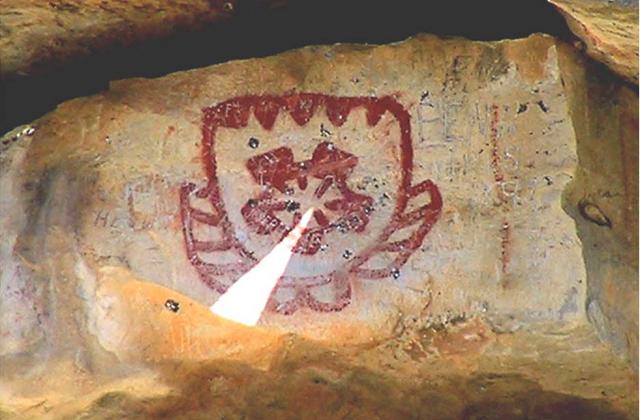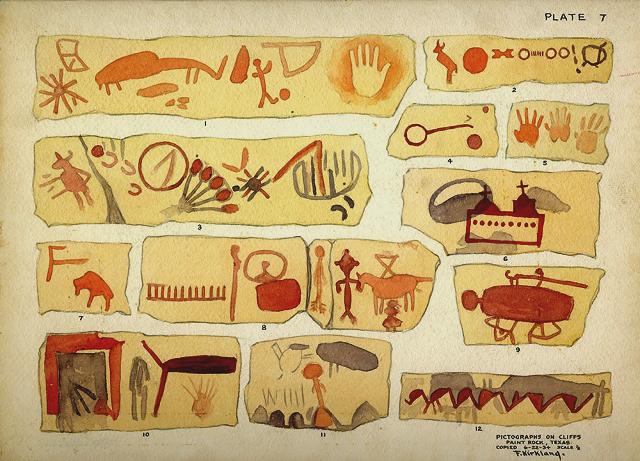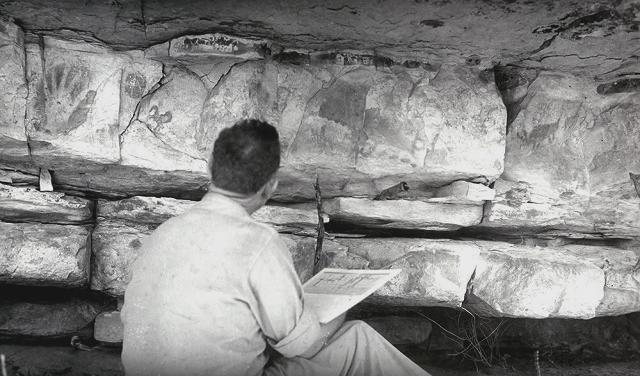 |
Canku Ota
|
 |
|
(Many Paths)
|
||
|
An Online Newsletter
Celebrating Native America
|
||
|
January 2017 - Volume
15 Number 1
|
||
|
|
||
|
Paint Rock Pictographs
Show Lipan Apache History
|
||
|
by Alysa Landry- Indian
Country Today Media Network
|
||
|
Pictographs
depict mythic heroes and monsters, and mark astronomical events
The legends of the Lipan Apache tell of emergence places, sacred ceremonies and the mythic heroes and monsters that fought in the underworld. Remnants of these stories, told in vibrant pictures, appear in Paint Rock, Texas, where a 70-foot cliff on privately owned land contains 1,500 pictographs. The pictures stretch for a half-mile on limestone walls on the banks of the Concho River. The site, called "significant" by the archaeologists who study it, was listed on the National Register of Historic Places in 1971. But this place holds personal significance to Bernard Barcena, chairman of the Lipan Apache Tribe of Texas. This is where Barcena traces his legacy. "That site is sacred to us," he said. "That area is part of our creation story, where God came and brought forth life." At Paint Rock, the Lipan Apache also recorded their modern history: arrival from the Great Plains in the early 1600s, establishment of a tribal identity and epic battles with the Comanche after which the Lipan corpses were "left in piles like leaves." In the 1750s, the Spanish established the first mission dedicated to converting the Lipan to Christianity, and in the ensuing years, the Lipan battled smallpox along with human enemies.
In the late 19th century, armies from the United States and Mexico began forcing the Lipan onto reservations, often grouping them with the Mescalero Apache. The remaining Lipan made a permanent home in the southern tip of Texas, where they continue to petition for federal recognition—relying, in part, on their oral and written histories. "Our history is written on the rocks," Barcena said. "We are not the only people who used those rocks, but you can see our stories." In fact, as many as 300 different tribes made their homes at Paint Rock and the art is believed to span 12,000 years, dating to nomadic Paleo-Indian people. The Lipan Apache, who camped along the bluffs in the 1600s, probably picked the location for the same reasons as their predecessors: protection from the elements, a vantage point to watch for enemies and a reliable source of water. But Lipan Apache and other tribes' stories also tell of an intimate relationship with the cosmos, of comets and eclipses, constellations and the changing position of the sun. Among the pictographs at Paint Rock are drawings that, once per year, align perfectly with the sun's rays—evidence of ancient astronomical calculations. For example, every winter solstice at noon, a dagger of sunlight punctures the center of a picture of a turtle. Every summer solstice at noon, the same thing happens with another pictograph, said Kay Campbell, owner of the ranch where the pictographs are located. Campbell's grandfather, a would-be professor researching nomads of the Southern Plains, happened on the pictographs in the 1870s. After determining that about one-quarter of the pictographs had been vandalized, the man shelved his dream of being a professor and instead purchased 15,000 acres of land to help protect the site. Now 89, Campbell grew up on the ranch. A child of the Great Depression, she fancied herself an amateur archaeologist and spent her childhood accompanying visiting intellectuals who sometimes traveled great distances to view the pictographs. But it wasn't until the 1990s when Campbell, then a retired teacher, stumbled on the solar markers. "I was in my 60s by then, and I thought I knew everything about these pictures," she said. "When I retired, I wanted to spend even more time with these pictographs, and I began to notice there were certain lines of light that seemed to interact with the paintings on certain days." Campbell called in some experts and together they discovered more paintings with connections to the sun. Diagonal rays illuminate specific pictographs at the spring and fall equinoxes, and researchers found additional evidence of complex, ceremonial paintings that interact with the sun on the summer and winter solstices.
The pictographs quickly became a tourist attraction, said Campbell, who leads groups of schoolchildren, researchers or sightseers along the limestone cliffs year-round. Her busiest days are solstice and equinox, when people come from all over the world to see sunlight play with ancient paintings. "I think this really contradicts what people assume about Native Americans," Campbell said. "People think pictographs are savage markings, but when you really look at this you understand that this is communication rather than art." The discoveries came as no surprise to Barcena, who said oral Lipan stories are full of "astronomical symbolism." For example, the ancient ancestors could predict solar eclipses, he said, and many stories told today reference a comet that flew across the sky every 500 years. "Our people had correspondence with the heavens," he said. "We believe that the knowledge we have of the cosmos we got directly from the people who brought it from the stars." |
||||||
|
|
|
|
||
|
|
||
| Canku Ota is a free Newsletter celebrating Native America, its traditions and accomplishments . We do not provide subscriber or visitor names to anyone. Some articles presented in Canku Ota may contain copyright material. We have received appropriate permissions for republishing any articles. Material appearing here is distributed without profit or monetary gain to those who have expressed an interest. This is in accordance with Title 17 U.S.C. Section 107. | ||
|
Canku Ota is a copyright ©
2000 - 2017 of Vicki Williams Barry and Paul Barry.
|
||
 |
 |
|
|
The "Canku
Ota - A Newsletter Celebrating Native America" web site and
its design is the
|
||
|
Copyright ©
1999 - 2016 of Paul C. Barry.
|
||
|
All Rights Reserved.
|
||


